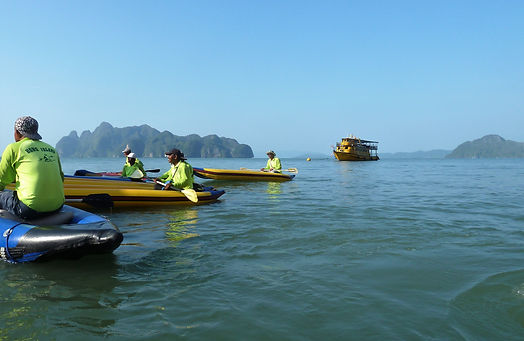
South Thailand
2- Gulf of Phang Nga
Koh Yao Noi, caves on the water,
and the sea gypsies
A bit of Koh Yao Noi
Another day, from the same immovable pier on the island of Phuket, here we are on the neighboring island just north of Koh Yao Yai,; this is Koh Yao Noi .
The approval of a few islets to the east and north will be illustrated elsewhere.
We will only stay there for lunch, on the east coast, on the edge of a small peaceful village, after having docked at the end of a long cement pontoon.
There, two Muslim shopkeepers so smiling that the folds of their eyes are no more than a sharp stylus, sell what appear to be sushi skewers, but most certainly from the few words of English on their modest information board, egg skewers. But what egg is it from?

A few words about batik
This technique of painting on fabric, by masking certain areas with wax, is very old.
But it is in Indonesia, a little further south, from the 12th and 13th centuries that it took its letters of nobility, reaching a commercial apogee as early as the 17th century.
So much so that in 2009, the art of Indonesian batik is inscribed on the list of the intangible heritage of humanity by Unesco, just like the art of the Basel carnival in Switzerland or the art of the Neapolitan pizza maker .
This list is an incredible tote.
However, under the steamroller of the geological scale of time, however tenuous and heterogeneous it may be, it is indeed the expression of the popular genius of the world, accumulation of knowledge and often empirical know-how which lead by dint of improvements and research to the accomplished masterpiece. Even if the value is only symbolic.



You can walk around the island on foot, by bike or by motorbike, which can be rented, on the small roads that crisscross the island.
In the first street, fuel cans "as before" with their hand pump ... You can find the photo on all the visitor sites.
Of course, impossible to enjoy this tranquility and this apparent quality of life during the good too short duration of our stage.
At the end of the meal, always on the same rhythmic rhythm, we are presented with grace and with great seriousness the way of painting on fabric, which we call the "batik".
The molten wax is spread according to the drawing made on the tissue using a kind of cannula with a pointed spout.
Then the paint is applied, varying the dilution, thus bringing beautiful nuances, finally the cold wax is removed.
The natural and final objective is of course to sell the exhibited pieces.
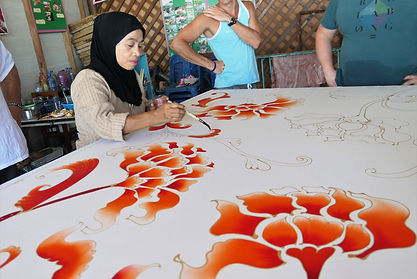
Low caves on the water
by Koh Hong
The following site is of an astonishing and spectacular geological originality.
It is located (see the map above) northwest of Koh Yao Noi on a small archipelago near the west coast of the Gulf of Phang Nga, northeast of the island of Phuket.
In the karst rocks, the persistent erosion of the waves digs deep overhangs just above the sea.
At the edge of these caves bass with no other bottom than the moving sea, the slow and incessant calcareous flows form huge and solid stalactites that seem to be made of cement, short tentacles with sometimes phallic contours, which dart their heavy and threatening points towards the sea, as if the powerful movement with which they seemed to be animated had suddenly frozen.
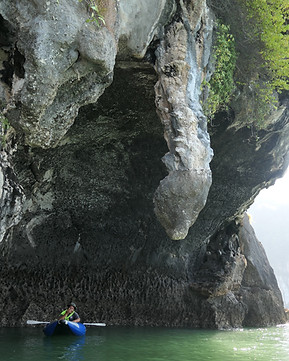
There, in the islet of Koh Hong, the dark vaults of a low ceiling were formed, tortured, suspended above the clear waters, possibly sometimes resulting from collapses.
These are then incredible entangled arches, jagged, spiky guts under which it is only possible to kayak by stretching straight backwards horizontally. We guide each other resting on the walls with the hands to avoid shocks painful with hard, sharp edges.
The islet visited owes its name to these rooms on the sea, since "hong" precisely means room.

From a platform boat, we embark by duo in a canoe piloted by an agile paddler seated at the back.
The peaceful canoe route between the standing rocks, sometimes forming narrow passages between cliffs with changing colors, opening elsewhere on other perspectives of distant rocks, is already remarkably picturesque.
Sure the whole world is there. But he tramples nothing but the bottom of the canoe hull. The bottlenecks are sometimes so narrow that it is certainly necessary, if only for the safety of visitors, not to turn it into St Mark's Square at the time of Venetian Carnival.
However, is there a management of quotas, which the chronology of the tides imperatively constrains?



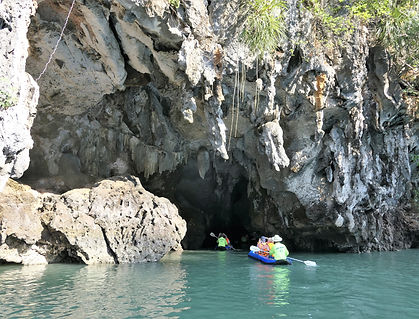

But the dazzling light pierces quickly, liberating, that of an exit. The total opening of the horizon is a relief after this spectacular and extraordinary course of sea lions.
A real natural attraction, fun, almost exhilarating.
Until the next collapse of those hellish vaults, next year ... or in two centuries.


Suddenly, through the narrow passages between the rocks, you come to a sort of sea glade enclosed in a small rocky cirque, of great and wild beauty.
For only escape, as in an "escape game" (in French in the text), you have to go through this semi-subterranean maze, labyrinth of rough asperities, dark and threatening, oppressive for the claustrophobic.

In retrospect, we say to ourselves that we should come there when the tide is lowest, and avoid trying to enter when it rises. If the guide speaks a little about it, all the kayak operators seem heedless of this agonizing threat; probable proof that they know perfectly well ... the chronology of the tides.
The senile old man falls back into childhood, and his V, very tired of victory, already foreshadows difficulties when soon he will first have to straighten up, then then and above all get out of the skiff.
We ask for a hoist !!

Koh Panyi, a splendid Muslim village on stilts,
"the gypsies of the sea"
From the small mountains in the north of our region, whose height sometimes reaches 1000 m, several short rivers have for millennia opened estuaries which widen quickly into the sea but all converge towards this cul-de-sac in the north of the Gulf of Phang Nga, fed by tropical rains and powerful monsoon flows. It is the Ao Phang Nga Maritime National Park.
The island we are approaching is this time nestled in one of these estuaries. It is called Koh Panyee, which is also written Koh Panyi.
From the south-west where we came from, over the thick carpets of the spreading mangrove swamps rise impassively the impressive rocky bars, all of the towering cliffs of the great islands. opposite, probably Koh Kiang and Koh Son Phi Nong.


Koh Panyi stands for "the island of the flag", the one planted here by the first occupants of the place, in the 18th century.
We are immediately seized when approaching the pontoon on the west shore by the surprising and magical spectacle of this rocky spur erect of its 100 meters like a blade, at the foot of which stretches on stilts the village with the colored houses, agglutinated against the beautiful Darussalam mosque, whose golden bulbs which rise from the pass is like a challenge to the cliff.
Or seek its protection, nest of chicks with the beak.
Most of the village on its pillars above the sea stretches from the mosque towards its southern end for 500 meters and towards the northeast at the foot of the rock for another 300 meters.
It forms a maze of roughly east-west oriented plank passages around a few north-south covered transverse streets (see the Google Earth image below and the aerial photo of the Krani tourism site) .


Despite the immense tourist success of the site, and the concession made by the villagers to this windfall, with the many shops and restaurants, the specific context of the village on its boards, the evidence found on every street corner of the active and quiet presence of the inhabitants give it a unique authenticity, a sort of bewitching charm that the seduction of smiles attaches even more.

Groups of tourists in a hurry meet, disperse, meet in this village-souk, invade the shops, taste the local dishes.

Tourism is also local and religious, Muslim visiting groups are different from Western visitors. The first ones perhaps drawn here as to a pilgrimage site.

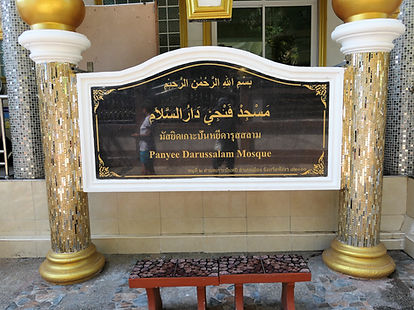
A bit of the hackneyed history-legend,
by Koh Panyi
The foundation of the village by two or three Indonesian nomadic fishing families from Java dates from the end of the 18th century.
One of them, T oh Baboo discovers the island, and plants a flag on a height. It signifies in this way to the two other sailors exploring other islands, that there are met the favorable conditions to settle (abundance of fish, ease of occupancy of the site, protected from the winds by the cliff rock) according to local legend. We do not know what this flag could look like, which is called "panyi" in Thai.
But they first set up their homes on stilts, because the configuration of the islet with its gentle slope to the south lends itself to this, but especially because at that time, the law of Siam reserved for the only Thai of origin the possession of the lands. No question for these newcomers to occupy other spaces than the areas reclaimed on stilts above the sea, even if the island is still uninhabited.
The laws then evolve, and authorize the appropriation of land.
So, on the plateau at the foot of the rock, the multiplying families build a mosque and dig a well of fresh water.
Today, those who are called "the gypsies of the sea", however very sedentary, represent a village of some 500 houses, inhabited by around 1700 people gathered in 360 families.
Tourism has of course largely supplemented their income. We see them, needy, busy everywhere without haste and without noise, in all the alleys and the large covered dock of the west bank.

The current football field is a little further, floating ahead on the sea, it seems more for fun and tourists (but who can provide the precision?).
Today, the village's junior team is one of the most highly rated in southern Thailand.
While a little further offshore the floating terraces of the fishermen wait.

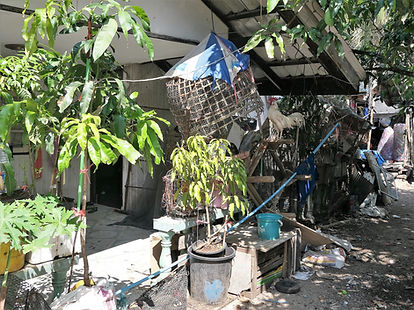
A bit like a tropical Venice in the morning the souks of Marrakech, the alleys and passages, the recesses, the rows, the small gardens where hens and roosters wander, the intercalated basins where motionless boats wait on a murky and frozen water, elsewhere stranded on the mud released by the low tide , the small restaurants which seem equipped with odds and ends, the local souvenir merchants, a tiara roof between glimpses, houses painted in bright colors, happy children who play or make whims, here is all the attraction of this place.

Farther on, brightly painted houses look pretty against the background of the mosque's golden bulbs.

The dapper mosque, perfectly maintained, is surrounded by a shiny metal barrier, with golden and silver chrome, which also delimits the cemetery.
On the continent around Khao Lak, we find the same kind of fence around the gardens of opulent houses, a sort of affirmation of the prosperity of their owner.
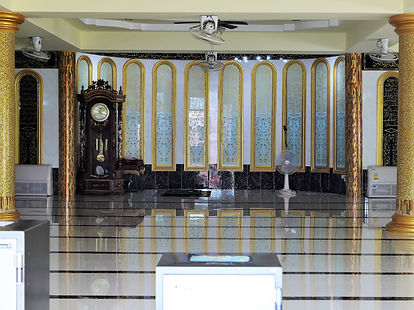

Towards the district to the southwest, an alley leads to the open sky, then runs along a passageway all the way to a school where classrooms follow one another, facing a huge playground which is a former football field. At the bottom of which watches, severe, the photo tarnished by the king's sun, framed in gold which was flamboyant, but which no longer shines either.
This space is probably the first football field built in the "go that I push you" by the young people of the village in 1986.
He was made famous when, during the World Cup of football (soccer here in English) in Mexico in 1986, children rode it with an enthusiasm that has become legendary by collecting all kinds of materials available.
Its history was the subject of a film which traces this small local epic.
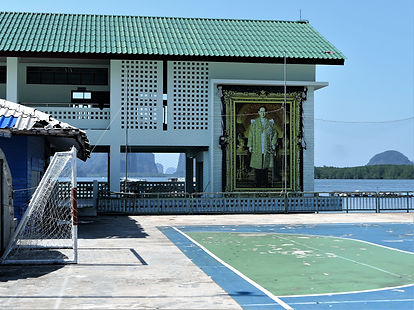

L'ancien terrain de foot devenu cour de récréation...

18-16/11

... et le terrain flottant d'aujourd'hui, pour le fun et le sport sans filet

Aerial photo of Krabi Province tourism site
... and some other illustrations of the nooks and crannies, in the slideshow below



